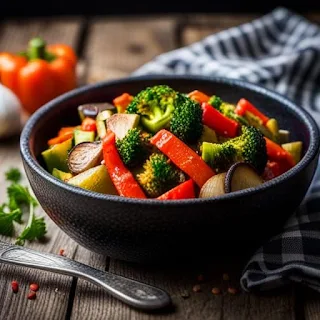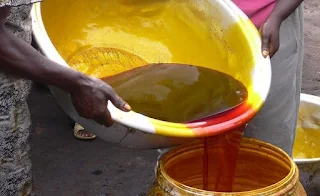Replace Olive Oil with Palm Oil
Try sautéing your favorite fresh vegetables in palm oil instead of olive oil.
Vermilion-colored palm oil has a mild, neutral taste and smell with a subtle hint of earthiness. It doesn't have a dominant flavor of its own, allowing the natural flavors of the ingredients it's used to shine through. When used in cooking, it adds a smooth richness to dishes without overpowering other flavors.
Palm oil is perfect for sautéing vegetables at high heat, similar to olive oil. Its high smoke point makes it great for cooking methods like sautéing, frying, and roasting.
Palm oil is made by grinding the palm kernel of the African palm oil tree, which is then extracted from the kernel. The palm oil tree is indigenous to West Africa, naturally occurring along the 300-mile coastline strip from the Gambia to Angola.
Sustainability in the palm oil industry and emphasizing that producers only source palm oil that has been produced in an ecological way is a major issue in the industry. Palm oil is produced in countries with large percentages of the world’s rainforests.
Replace olive oil with palm oil when cooking sautéed vegetables.
When you replace olive oil with palm oil, some flavor, texture, and appearance differences will appear. Palm oil has a milder flavor compared to the distinct taste of olive oil, so the dish may have a slightly different taste than your palette is used to. Also, palm oil is orangish-red in color, which will change the dish color; red colors are associated with happy, healthy foods.
Sautéed Vegetables with Palm Oil
Ingredients
1/2 cup each of diced carrots, bell peppers, broccoli, zucchini, onions, eggplants, and mushrooms
2 tablespoons palm oil
Salt and pepper to taste
Directions
Heat a sauté pan over medium-high heat. Add palm oil to the pan and let it heat up. Once the oil is hot, add vegetables to the pan. Sauté the vegetables, stirring occasionally, until they are tender.
This usually takes about 10-15 minutes, depending on the size of the vegetable pieces. Season the vegetables with salt and pepper.
Remove from heat and serve as a side dish or as part of a larger meal. The color of the dish will be slightly different due to the beautiful orangish-red hue of palm oil.






























